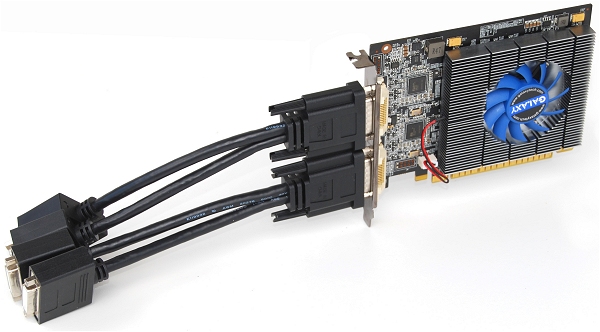MDT GeForce GT 520 in Detail
The GT 520 is one of the few products in the GeForce 500 series that can be cooled passively, making it a solid choice for quiet, compact systems. The card is said to consume just 29 watts of power under load, which is a fraction of the 116 watts needed to power its bigger brother, the GTX 550 Ti.


A big plus about the GeForce GT 520 consuming so little power is that it doesn't require an external power source. The PCI Express bus alone is capable of delivering enough current. The card also generates very little heat and as mentioned, it can be passively cooled. However, Galaxy's jazzed up version employs a small 55mm fan that cools a mid-sized 95mm x 85mm heatsink.

Compared to the Radeon HD 6450, which measures 16.5cm long, the MDT GT 520 is a shorter 14.5cm. That said, Galaxy's card is also full height whereas most GT 520s are low profile.
The GT 520's core configuration includes just 48 SPUs, 8 TAUs (Texture Address Units) and 4 ROPs (Rasterization Operator Units). That's considerably less than other cards in the series and it's similar to that of 2008's GeForce 9600 GSO.


Core clock speed is set at 810 MHz, which should be good for 155.5 gigaflops of computing power, while the GDDR3 memory operates at 900MHz. The GT 520 can come with either 1GB or 2GB of memory – Galaxy's has 1GB. As with all low-end cards, we recommend you purchase the lowest memory capacity model possible because they're cheaper and don't sacrifice much, if any performance.
There are no bridge connectors on the MDT GT 520 as SLI is not supported. However, the card does support a pair of dual DMS-59 connectors which provide quad DVI-D outputs. The DMS-59 is a 59-pin connector often used on graphics cards to expand monitor support and provides two DVI or VGA outputs.

A special adapter cable is needed to convert DMS-59 (digital) to DVI (digital) or VGA (analog). Galaxy includes two DMS-59-to-DVI adapters for quad DVI support. The dual DMS-59 connectors are driven by dual IDT VMM1403 ViewXpand multi-monitor controllers.

The VMM1403 uses a single DisplayPort interface to span up to four monitors. Unfortunately, it can only support resolutions as high as 1920x1200.
Galaxy includes its own software, called EZY Display, which lets users quickly switch between split screen and merged modes. The software is very easy to use and can be hidden in the system tray. Merge mode is really only useful to gamers, so we expect it to be widely unused with this card, but it's there nonetheless.
